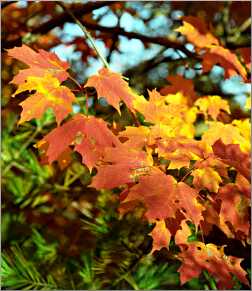What makes leaves turn color?
Look for consistent summer moisture, followed by warm days and cool nights.

© Beth Gauper
Every year, it happens like magic: In September, the uniform green of the hardwood forests starts morphing into a rolling wave of reds, russets, golds and orange.
Often, the colors are glowing, as if lit from within, but sometimes they're dull and faded. Some years, the maple color is spotty, turning here and there over several weeks, and there's no real peak.
In a bad year, there's barely any color at all, just mousy yellows on leaves that drop in the first stiff wind.
Why? And what kind of conditions produce the best foliage color?
Here's a particularly cogent explanation from Susan Benson, former director of education at the Cable Natural History Museum in the northwest Wisconsin town of Cable, one of the best places to see fall color. In her Nature Watch newsletter, she wrote:
"Here are the fall-color basics. Three types of pigments are involved in autumn color. The first is chlorophyll, which gives leaves their basic green color. Chlorophyll is necessary for photosynthesis, the chemical reaction in which plants use the energy of sunlight to make sugars.
"The second pigment group, called carotenoids, produces yellow, orange, and brown colors. The last essential pigment, known as anthocyanin, produces red, purple and crimson colors.
"Both chlorophyll and carotenoids are present in leaves throughout the growing season. Most anthocyanins are produced only in autumn, in response to bright light and excess plant sugars within leaf cells.
"As the nights grow longer, chlorophyll production slows to a halt. Its green color fades from the leaves; the caroteniods and anthocyanins are then unmasked to show their colors.
"The vibrancy of the colors is related to weather conditions that occur before and during the time when the chlorophyll in the leaves is dwindling. A series of warm, sunny days and cool, crisp but not freezing nights seems to bring about the most spectacular color displays.
"During these warm days, a lot of sugars are produced. The cool nights and the gradual closing of veins leading from the leaf prevent these sugars from moving out. Lots of sugar and lots of light spur the production of the brilliant anthocyanin pigments.
"The timing of the color change also varies by species. For example, oaks show their colors long after other species have already dropped their leaves.
"The differences in timing among species seems to be genetic, for a particular species at the same latitude will show the same coloration in high elevations at about the same time as it does in warmer lowlands.
"Here is the unknown wild card. The amount of moisture in the soils also affects autumn colors. A late spring, or severe summer drought can delay the onset of fall color by a few weeks. They can also lower the intensity."
For more about looking for the best fall color in the Upper Midwest, see Pursuing the hues.